- Joined
- Jul 1, 2014
- Messages
- 3,472 (0.97/day)
What started as a giant build log in the Caselabs TX10-D has become a series of tests and reviews now! This time a test on something most people don't compare- 480 and 560mm radiators- because most of these don't fit in a typical case. But seeing how I can fit ALL 10 rads being tested simultaneously in this one case, I decided to go ahead and check them out. This is going to be a big, continuously updated thread with a lot of pictures (each rad essentially gets a review in here) so I welcome all for the ride.
1) Unboxing and Overview
Let's take a look at the radiators in the arena:
EK-Coolstream PE 480 (Henceforth referred to as EK PE480)


EKWB color coordinates their components so green is radiators, orange is water blocks and so forth.

Inside the outer box (yes, it isn't a sleeve as with their blocks) is another box.

Opening the box we see the bag of screws on top of the radiator unit
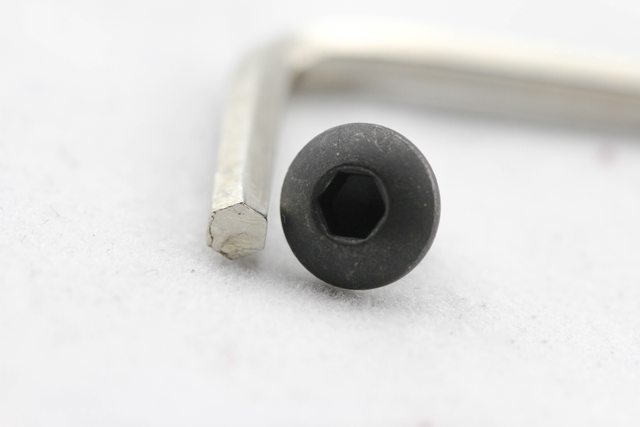

Pretty much every radiator (other than the Alphacool Monsta) comes with 4 x number of fans of 30mm and 6mm long screws. So don't expect the fancy arrangement henceforth
EK has chosen to use UNC 6-32 thread size and screws for fan/radiator mounting. To aid in installation, they have provided a small Allen key.




The radiator itself is snugly packed inside a paper sleeve and then in bubble wrap- safe enough to be shipped across the world with no hitches.

The radiator has sharp edges and a clean, minimalist look. The frame itself has a matte finish and is easy to dust off. The unit measured in at 530mm long x 130mm broad x 40mm wide.


Here you can see the mounting holes. If you use the provided screws with a standard 25mm fan or directly mount it to a case/stand then there will be no issues with any radiator. But in case you use your own screws that are too long, then they will pierce the tube channels so be careful and double check the screws before using them.


There are 2 threaded extenders that each accept a male G 1/4" fitting on the radiator and come covered by plastic caps. These are just meant to protect against any dust/contaminants getting in so don't use them as a stop plug.

The core is brass and comes clean from the factory. In fact, as we will see later, all the rads go through a Mayhems Blitz Pro cleaning and the results are documented. The radiator is a dual pass, side to side flow type as with other radiators in this roundup unless specified otherwise.

The fins are uniform across the radiator which is always good to see- no bent or scratched fins in this sample.
Now, let's define a fin (yes, we had to come to that):

Each "/" and "\" is 1 fin each. So in the picture above, there are 16 fins in the enclosed section. This number does not change if you split them up:

Still 16 fins in the enclosed section, just happen to be 16 split fins. So by this terminology that academia and industry typically follows, the EK PE480 has a FPI of 19 and not 38 that they advertize- a true 38 FPI core will be terribly restrictive in terms of air flow. I measured an FPI of 18-19 on average here. Each fin is also ~30 microns in width as measured by a micrometer. While we are measuring, the radiator holds approximately 300 mL of fluid, has 12 flattened tube channels each ~2.19 mm wide. All this will be in a "cheat sheet" later on.
One more feature that the EK PE480 has is a removable core- this makes painting the outer frame a lot easier without having to mask off the core. This is a feature shared by the XSPC AX480 as well and I will demonstrate it in there (slightly easier in that case). As of October 23, 2014 the EK PE480 costs $89.95 in the US.
XSPX AX480 V1


The radiator comes in a nice box again, and has a warning label about using the provided screws and in the right manner.
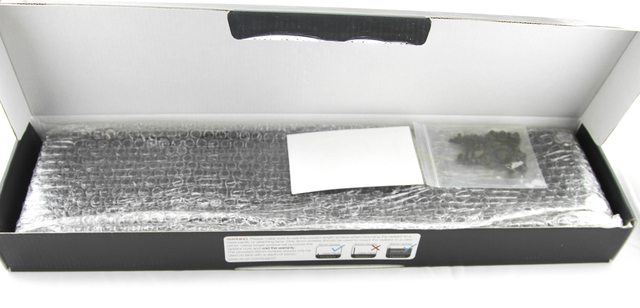
Inside the box is the bag of screws on top of the radiator.

The screws are UNC 6-32 with a standard Phillips head so no driver comes with this.

The radiator comes protected in bubble wrap.

Here is everything that comes in the box- the radiator and 2 sets of 16 screws each. The trend so far is providing enough fans for push or pull only.

The radiator comes with a built-in gasket if I can call it that. Whether or not it aids in performance will be seen later but it definitely adds to the clean look here in my opinion.
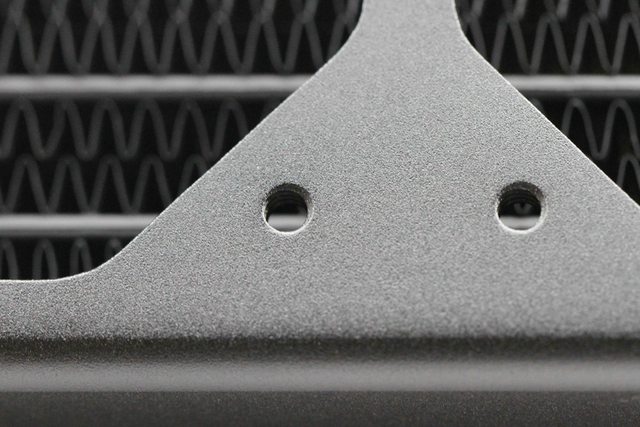

As seen above, it is a similar case as with there being no screw protector (Incidentally, shouldn't these be called tube channel protectors instead?) and longer screws piercing the tube channels. Just use the provided screws properly and no such thing will happen.

The frame has a nice matte finish that is easy to dust off as well. The dimensions were 528mm long x 130mm broad x 40mm wide.

The fins are uniform across the board in consistency.
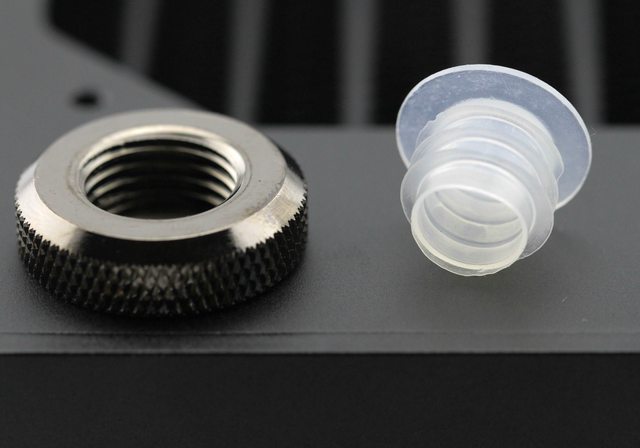
There are again 2 extenders on the ports that accept any G 1/4" fitting. These extenders come with plastic caps on them to stop physical contamination during storage and transportation.


In order to remove the core for painting the frame, the extenders need to be removed first. I had to use pliers on one of these, so if that's the case then be sure to use a piece of cloth or paper in between so as to not scratch the fittings. Note that disassembly was done after all tests were completed to prevent any possibly installation factors.

Next remove the 4 Torx T10 screws on either side with an appropriate driver (I did it the other way round as seen in the pictures):


The radiator core is help by tape but once the two extenders and one side plate is removed, it should easily slide right out:



Once the frame is ready to go, reverse the steps and assemble it back. XSPC also includes a desk stand to take advantage of this feature. The radiator has 30 micron wide fins at 18-19 FPI, 12 channels 2.2 mm wide, was clean out of the factory and holds 300 mL of fluid. At this point, I contacted both EK and XSPC because these two radiators were very similar in specs. Here is a direct quote from EK:
So if you see similarities in radiators across brands in terms of packaging or otherwise, now you know. The XSPC AX480 V1 costs $114.95 as of October 23, 2014 in the US.
XSPC AX480 V2
As far as I know, this is the first public mention of the AX V2 series. You can find out if your sample is a V2 by seeing if there is a sticker "V2" by the barcode on the box. Mine did not have the sticker but I have been told this is definitely a V2. The only difference between AX V1 and AX V2 is with the fin design so this will be a short section.
Let's look at fins:

These are louvered fins on the XSPC EX560 (Yes, I jumped a bit here) with the cuts opened up. The louvering introduces local turbulence in the air flow, and this can be useful or even worsen performance depending on the situation. By contrast, these are unlouvered fins on the XSPC RX480 V3 (Another jump):

As you can see, there are no cuts at all. Louvering fins ends up only hurting performance at low fan speeds/air flow and this is something you will see being a feature of the rads excelling at such conditions. Now let's look at the AX480 V1:

The AX480 V1 has louvered fins, and I expected that the AX480 V2 would have no louvering. But:

There are still cuts, but not fully opened up. I am not sure if this is enough to have an effect but we will see later. Everything else is the same, and the AX V2 will replace the AX V1 (or already has depending on the region) at the same price point. In fact, when you have them together makes it impossible to distinguish one from the other unless looking very closely:

XSPC RX480 V3


No confusion about the version here, the RX480 V3 comes in a white box and has the same warning label as before:


Inside is the bag of screws on top of the radiator as well 2 XSPC stop plugs.

These screws are UNC 6-32 with a Phillips head and the stop plugs are nickel plated and low profile.


The radiator itself is packaged in a paper sleeve which is then inside bubble wrap.


The frame has a nice matte finish and the radiator dimensions are 515mm length x 130mm breadth x 56mm width.

The fins are once again very consistent across the board.

There are 4 ports here- two on the top/bottom and two on the side- that come covered in plastic caps. Hence the reason why 2 stop plugs are included. I like having multiple ports to aid in filling, bleeding, draining and also giving options with tube routing so this is a welcome move. One of the 4 ports was slightly cross-threaded and I had to use a G 1/4" tap to get the stop plug to screw in properly.


There are no screw protectors but screws that are longer than what should be used will not piece the channels- they will only bend in some fins with minimal performance effects at best.
The RX480 V3 came in clean out of the factory, holds 500 mL of fluid, has 30 micron wide fins at 13 FPI, 9 tube channels that are 2.1mm wide and costs $122.95 in the US as of October 23, 2014.
XSPC EX560
The radiator is packaged in a similar manner to the RX480 V3 so I will post pictures here interjecting in only when need be:







The frame has a matte finish and the radiator dimensions are 595mm length x 143mm breadth x 35.5mm wide.

The fins are not uniform throughout in this case, with quite a few bent out of the box itself.

No extender fittings here just like with the RX480, and the 2 ports on the radiator come with plastic caps on.


There are no screw protectors here, and there is enough wiggle room for the screws to pierce the channels if (a) too long a screw is used improperly and (b) it is screwed in at an angle. Again, nothing that a normal usage with the provided screws will experience.
The EX560 had minor residue left inside after the soldering/brazing process, holds 285 mL of fluid, has 30 micron wide fins at 17-18 FPI, 13 tube channels that are each 2.05mm wide and costs $89.99 in the US as of October 23, 2014.
Alphacool NexXxos Monsta 480 (Henceforth referred to as Alphacool Monsta 480)



In my case the radiator actually had shipped with no accessories in the box other than a few black screws so I had to contact the retailer and get the accessories separately. The actual screws are supposed to be copper to go along with the provided copper stop plugs and logo sticker. But less than 1 month of usage had resulted in discoloring:


Assuming nothing's wrong with your unit, there will be a box with 8 pouches of screws in it. Each pouch will have 4 screws- either 30mm long for mounting a standard 25mm wide fan into the radiator or 35mm long for going through case/gasket->fan->radiator. Based on this, I would believe the manufacturer intends for this radiator to be used in a push-pull fan configuration as opposed to every other radiator in the roundup. The screws are type M3 and have a hex head- this may require the use of a washer if your case fan holes are bigger than the screw head.


There 7 ports on the radiator- 2 each of the top, side and bottom on one end and a single port at the bottom on the other. This again is very handy to fill, bleed, drain a loop and route tubing easily.




There are no logos anywhere and instead you get a few stickers for you to place accordingly once installed so as to have the logo oriented right side up. I like that they give us a choice here! The radiator frame has a glossy finish that picks up stuff easily but can be wiped away as well- not a dealbreaker by any means unless the radiator comes with dings and scratches out of the box:

The radiator dimensions are 522mm length x 125mm breadth x 86mm width. Note that these are not 80mm wide as many believe and can result in an incompatibility if you haven't accounted for the large size.

The fins are pretty inconsistent to be honest with even the FPI having a broad range as we will see soon.


On the plus side, even if you use the 35mm screws by mistake instead of the 30mm long ones, there is a screw protector plate throughout to make sure they hit the plate first and not the tube channels.
On the negative side though, the radiator was quite dirty out of the box- something Alphacool/Phobya really need to address before more and more customers decide to go with other options. The radiator holds 870 mL of fluid, the fins are 25-35 microns in width at an FPI of 8-10, there are 10 channels each of 2mm width and the radiator costs $139.95 in the US as of October 23, 2014.
HardwareLabs Black Ice Nemesis 480GTS U-Flow(Henceforth referred to as Black Ice Nemesis 480GTS)
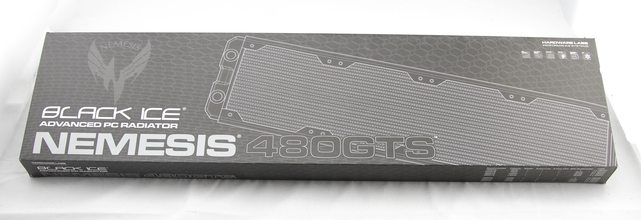
The GTS (S for Stealth) comes in a nice box with the Nemesis writing in silver (as opposed to gold in the case of the GTX versions).
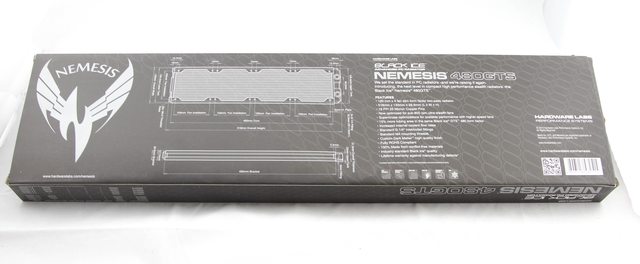
No, that isn't a Corsair Gaming logo
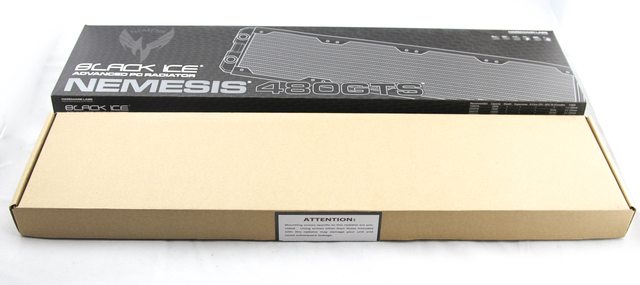
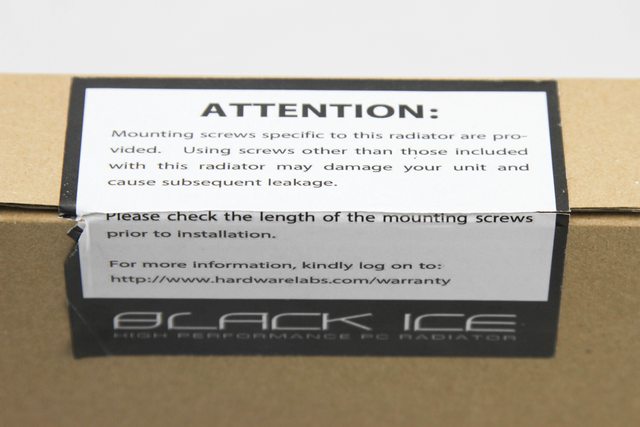
Inside is another box with a warning label about proper screw usage.
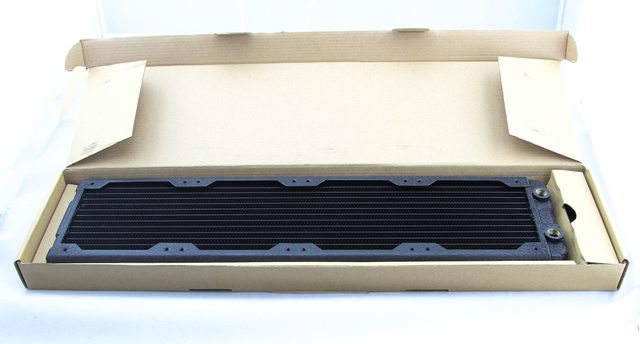
Opening it up, we are greeted to the radiator immediately. No paper sleeve, no bubble wrap. Normally I would be ok with this seeing how snug everything is and the rad being in perfect condition to prove that point but those flaps at the top are just asking for trouble- in fact a few people have already mistakenly had the flaps close down at an angle down on the fins immediately below resulting in bent fins with paint scratched off. Upon talking to HWL about this, I was informed it was an issue with a small batch of products due to the packaging providers and steps had already been done to rectify this (and they had too, as we will see very soon).
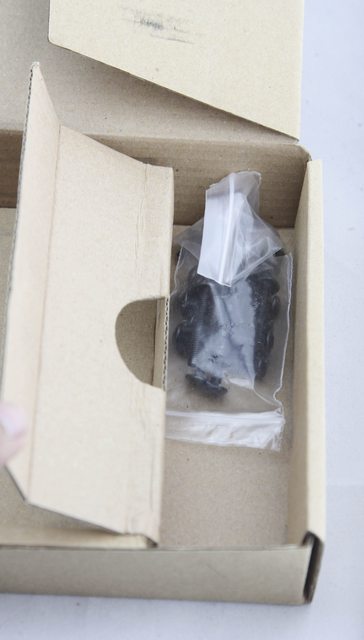



The screws are in the side compartment with 16 each in the M4 type, 30 and 6mm long. The radiator has a "Dark matter" finish for most customers (A matte finish for the European market, not due to any laws/regulations but simply from a market poll):
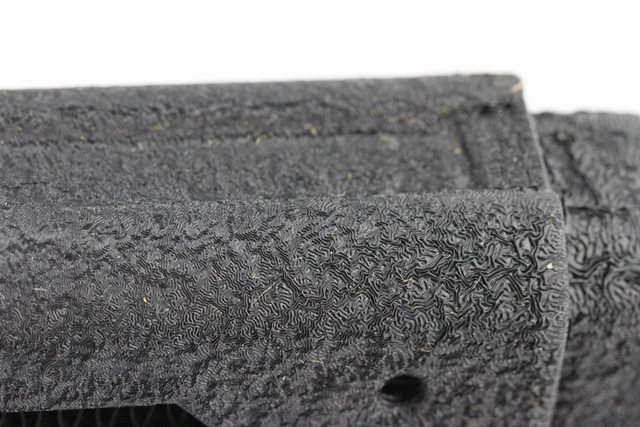
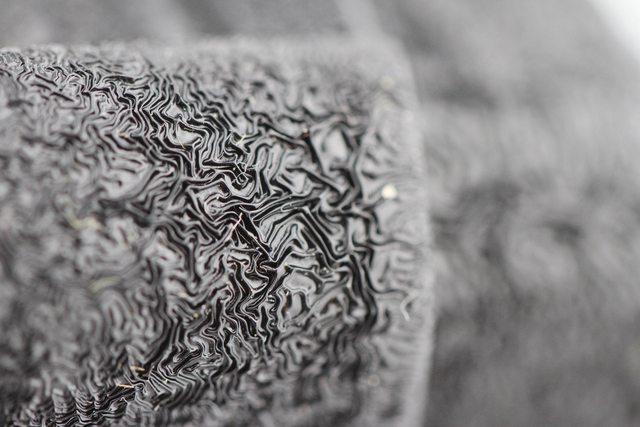
It is a very unique look by far (In fact, I am told HWL came out with the matte finish first as well) and definitely something one needs to see in person before deciding whether they like it or not. The finish means dust and other contaminants get retained but on the other hand they are also not easy to spot:

The radiator dimensions are 520mm length, 132mm breadth and 29.5mm width.
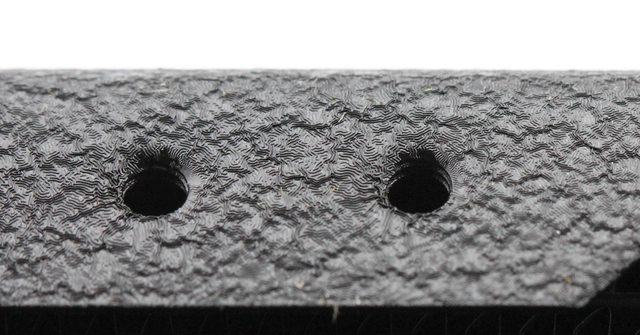


Not the easiest to photograph but hopefully you can see that there are screw protectors here in case someone uses the wrong screws.
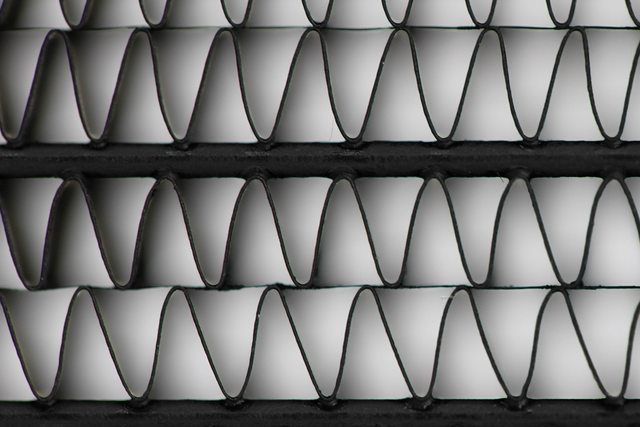
The fins were extremely consistent across the board with no visible damages at all!

There are two ports that come in uncovered but this was one of the cleanest radiators out of the box.
The radiator holds 190 mL of fluid, has 25 micron thick fins at 16-17 FPI, and 12 tube channels at 1.22mm width each. Definitely the thinnest fins and tube channels out of any other brand in this test. It costs $98.95 in the US as of October 23, 2014 and comes with a limited lifetime warranty- something no one else offers!
HardwareLabs Black Ice Nemesis 480GTX (Henceforth referred to as Black Ice Nemesis 480GTX)

The "Nemesis" wording on the GTX (X for Xtreme) is in gold as opposed to silver with the GTS variant.


Here we see what I was referring to above with the updated packaging- I am content with the packaging now but I can see where others would prefer at least a bubble wrap sleeve on top of this.


The screws (same as with the 480GTS) are in the side compartment again.

The Nemesis 480GTX has the same dark matter finish, just in a bigger frame. Unlike the Alphacool formula of having the same FPI but increasing the core thickness/number of rows, here the thicker GTX frame also means a differently optimized core and fin structure. The dimensions are 518mm x 133mm x 54mm.

Again, extremely consistent fins that were flawless out of the box.

No screw protector here, but the screws can only hit the fins as the tube channels are offset. I still only recommend using the provided screws of course!
The radiator has a similar flow direction (Front to back) to the GTS variant, holds 370 mL of fluid, has 25 micron thick fins at 13 FPI, and 12 tube channels at 1.22mm width each. It costs $176.95 in the US as of October 23, 2014 and comes with a limited lifetime warranty. Oh, and it was the cleanest radiator of all the ones tested in terms of the Mayhems Blitz Pro treatment.
One important thing to note is that the Nemesis radiators (only the GTX, not the GTS variant) follow the front to back flow scheme and not side to side. When the two ports are facing you, the port on the right has a lower travel distance to the core compared to the port on the left. So depending on the way you orient the fans, choose the inlet and outlet accordingly. If you have the inlet on the right then the side with the barbs is the hot side and the other side is the cold side.
HardwareLabs Black Ice Nemesis 560GTX (Henceforth referred to as Black Ice Nemesis 560GTX)
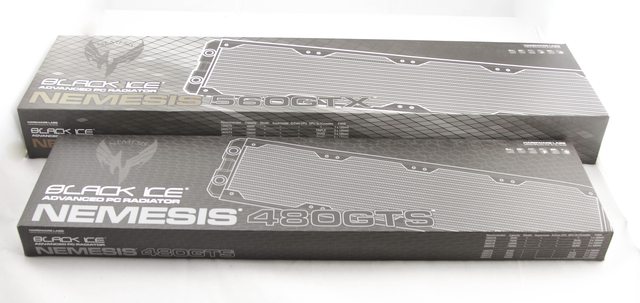
This is the 560mm (4x140) version of the Nemesis 480GTX and shares all the similar features except with these changes: Dimensions are 592mm x 153mm x 54mm, fluid volume 510 mL, 16 tube channels each 1.22mm wide and costs $207.95 in the US as of October 23, 2014.
HardwareLabs Black Ice SR-1 560 (Henceforth referred to as Black Ice SR-1 560)
This was purchased used from the original owner who had had minimal usage on this with just distilled water for a couple of weeks. So other than missing the original packaging and screws, the radiator itself was is pristine shape (after having used a Datavac blower to remove any remnants of dust on the fins).


The frame has a matte finish and the radiator dimensions are 605mm x 152mm x 56mm.

The radiator has only 2 ports and follows a standard side to side flow direction.

One of the sides has a larger gap to the core than the other to act as a shroud and help eliminate dead spots in air flow.

The fins are consistent across the radiator.



No screw protectors here but the tube channels are offset and so longer screws will only hit the fins.
The rad holds 530 mL of fluid, has 30 microns thick fins at 9 FPI , 14 tube channels each of 2.02mm width and costs $197.95 in the US as of October 23, 2014.
So here's the "cheat sheet" referenced above:

2) Liquid flow restrictions
Testing methodology:- I used a Swiftech MCP50X pump with a FrozenQ 400mL cylindrical reservoir. The pump was powered by a direct SATA connection to an EVGA 1300G2 PSU, and was controlled by an Aquacomputer Aquaero 6 XT. There was an in-line flow meter previously calibrated, as well as a Dwyer 490 Series 1 wet-wet manometer to measure the pressure drop of the component under test- in this case each radiator. Every component was connected by 1/2" x 3/4" tubing, compression fittings and 2 T-firings with the manometer.


The lower the pressure drop from the component, the better it is. Most rads are not as restrictive as, say, a CPU waterblock so this won't affect most people unless you plan to have a lot of them (especially the Nemesis GTS radiators where the thin channels and the core optimized for performance has a clear effect). The EK PE and XSPC AX radiators are indistinguishable here which, knowing about the common OEM, does make sense.
3) Air flow restrictions
Testing methodology: For the 480mm radiators, a Noiseblocker-eLoop B12-4 was mounted in "push" and an Extech 45158 thermo anemometer was placed 6" away from the rad/fan assembly and in the same spot each time to eliminate the effect of deadspots or variation in the X/Y axes. For the 560mm radiators, a Noiseblock Blacksilent Pro PK-3 was mounted in "push". Both fans were powered and controlled by the Aquaero 6 XT.
I realize linear aiflow isn't as useful a metric as volumetric airflow. But at this point, without a sealed box with a duct of controlled size/shape or even a closed adapter of sorts, I can't do much better. Knowing that these numbers also vary from fan to fan, I can only display these to used relatively to each other and not with any other reviewer/tester's results.

While this is a bit of a jumble, somethings are pretty clear- the Alphacool Monsta predictably suffers from least airflow through it despite the low FPI. The XSPC RX480 V3 and the two HWL Nemesis rads have the most linear airflow through them consistently.

Not much of a surprise in here given what we know of the fin and tube channels, the SR-1 560 has the most airflow compared to the other two. But how would the liquid and air flow restrictions effect thermal performance?
4) Thermal tests
Testing methodology: Everything needed (monitor, peripherals, motherboard w/CPU and GPU, radiator, PSU and so forth) was placed in a sealed climate controlled box at 25 +/- 0.05 ºC. Each radiator was connected by Koolance QD3's for easier changing of fans and radiator. The flowrate was held at 1 GPM constant (because liquid restriction tests have already been done) and I believe people generally try to maintain the same flowrate and not hold a pump at a fixed power if controlling them is an options- that's how I do it personally anyway. The CPU, an Intel i7 4770k at 4.6 GHz and 1.3 Vcore, was held at a constant load using a custom XTU profile and the GPU, an EVGA GTX 780 Ti Classified KPE under load from Unigine Heaven 4.0 at 1080p/extreme HD settings, was overclocked and overvolted such that the total system power draw was 850w as measured by a Kill-A-Watt unit inside the hot box. Of course this doesn't mean the rads were attempting to dissipate 850w of heat, especially after PSU efficiency and power consumption from the other components (RAM, fans, pump, SSD) are taken into consideration. My point here was to maintain a near constant heat load into the liquid loop and this helped achieve stable liquid loop temperatures (As measured by 2 separate in-line temperature sensors hooked up to the AQ6) pretty quickly. The tubing and fittings were insulated by a heater sleeve with the heat function not being utilized (doesn't provide anywhere enough heat to get to the 700+ watts I wanted anyway).
I would love to get a water heater with a variable controller instead to make things simpler. But the in-line variants seem to top off at ~300-400w which really don't test out quad rads enough, and the bulk heaters are simply not safe enough in my opinion to use in an isolated, sealed chamber. If there are safer options that don't break the bank, I would love to re-test so I can then accurately map out the watts dissipated at a given delta T (loop - ambient) value for example.
Finally, each fan speed is indicated in the bar graphs below as well as the fans used. I tried my best to not undervolt any fan as much as possible to remove that slightest bit of possible variation from run to run when undervolting and that's why you will see the use of several different fans- all in "push" at this point. To put things in perspective in terms of noise level, the B12-1 at 600 RPM registered 20 dBA and was barely audible even when run outside in the open, and the B12-4 at 2200 RPM registered 39 dBA and was sufficiently loud so that I could hear them through the hotbox (which isn't acoustically sealed, so acts as a typical case I would say).








Again, I have to say these results should be taken relative to each other only at this point due to the different testing methodologies and fans used. I would love to be able to put out watts dissipated vs fan CFM and accompany it with a library of information to get CFM vs RPM values for as many fans as possible. But that's not something I can do realistically as a hobby/out of interest.
Having said that, we can see a few things here:
1) The XSPC RX480 V3 and the two HWL Nemesis rads are great at the lower fan speeds/air flow. The unlouvered fins and optimized cores, channels and fins all work together.
2) The EK PE480, XSPC AX480 V1 and XSPC AX480 V2 are pretty much the same for all intents and purposes- buy as per your preference of looks/brand/warranty/price. They also only are in favorable conditions at the higher fan speeds/air flow.
3) The Alphacool Monsta is a monster at only higher fan speeds/air flow.
4) The HWL rads scale great with airflow while the XSPC RX V3 does not- goes to show that liquid and air flow restrictions don't tell everything and the entire package can affect things.
Now for the 560s:





Not much of a surprise here given the smaller sample size of radiators, and also knowing that the SR-1 has a successor coming in very shortly. The EX560 also costs a lot lower but all that being said if you can afford it then I don't see anything really beating out the Nemesis 560GTX consistently across various fan speeds.
Final thoughts
Performance should never be the sole metric to base a radiator choice on. In fact, never buy a radiator separately- get the radiator and appropriately chosen fans in terms of airflow, static pressure and noise levels you are comfortable with. Those bar graphs above also don't tell the entire story, especially when the difference is a couple of ºC in some cases. Look at the entire package- accessories, build quality, warranty, radiator ports and other features and definitely the price point. The above results will hopefully help people make decisions but if you quote these anywhere (and you are of course free to do so) then please mention that the restriction and thermal results should be taken relatively within each set only. Whenever I see people quote results from Martin or Bundy saying "xxx" rad is better than "yyy" rad at "zzz" RPM, it frustrates me a little knowing that the testing methodologies are different and the fans play such an important role. If I were to run the 480mm rads with an airflow oriented fan, then the XSPC RX480 V3 would have probably been the leader at most fan speeds! That's why I placed the fan details in each thermal test as well in order to minimize this potential issue.
I realize this is not a conclusive roundup by any means, heck it isn't even an absolute one. As I mentioned before, I would have definitely preferred to be able to post Watts dissipated vs fan CFM for each radiator. This would be a much better scientific report, but that also doesn't help most people without providing (a) an accurate means of estimating how many watts each particular rad in each particular system would have to dissipate for a given delta T value and (b) having a compendium to get CFM vs RPM for each particular fan being used. This is definitely not a 1 person job even if he/she is paid to do nothing but this. So I want to encourage people to start sharing their own results- even small tests are better than nothing! Just make sure you do it properly and rigorously. Ok that was my small rant, and I am done now! Thanks for reading
1) Unboxing and Overview
Let's take a look at the radiators in the arena:
EK-Coolstream PE 480 (Henceforth referred to as EK PE480)


EKWB color coordinates their components so green is radiators, orange is water blocks and so forth.

Inside the outer box (yes, it isn't a sleeve as with their blocks) is another box.

Opening the box we see the bag of screws on top of the radiator unit


Pretty much every radiator (other than the Alphacool Monsta) comes with 4 x number of fans of 30mm and 6mm long screws. So don't expect the fancy arrangement henceforth

EK has chosen to use UNC 6-32 thread size and screws for fan/radiator mounting. To aid in installation, they have provided a small Allen key.




The radiator itself is snugly packed inside a paper sleeve and then in bubble wrap- safe enough to be shipped across the world with no hitches.

The radiator has sharp edges and a clean, minimalist look. The frame itself has a matte finish and is easy to dust off. The unit measured in at 530mm long x 130mm broad x 40mm wide.


Here you can see the mounting holes. If you use the provided screws with a standard 25mm fan or directly mount it to a case/stand then there will be no issues with any radiator. But in case you use your own screws that are too long, then they will pierce the tube channels so be careful and double check the screws before using them.


There are 2 threaded extenders that each accept a male G 1/4" fitting on the radiator and come covered by plastic caps. These are just meant to protect against any dust/contaminants getting in so don't use them as a stop plug.

The core is brass and comes clean from the factory. In fact, as we will see later, all the rads go through a Mayhems Blitz Pro cleaning and the results are documented. The radiator is a dual pass, side to side flow type as with other radiators in this roundup unless specified otherwise.

The fins are uniform across the radiator which is always good to see- no bent or scratched fins in this sample.
Now, let's define a fin (yes, we had to come to that):

Each "/" and "\" is 1 fin each. So in the picture above, there are 16 fins in the enclosed section. This number does not change if you split them up:

Still 16 fins in the enclosed section, just happen to be 16 split fins. So by this terminology that academia and industry typically follows, the EK PE480 has a FPI of 19 and not 38 that they advertize- a true 38 FPI core will be terribly restrictive in terms of air flow. I measured an FPI of 18-19 on average here. Each fin is also ~30 microns in width as measured by a micrometer. While we are measuring, the radiator holds approximately 300 mL of fluid, has 12 flattened tube channels each ~2.19 mm wide. All this will be in a "cheat sheet" later on.
One more feature that the EK PE480 has is a removable core- this makes painting the outer frame a lot easier without having to mask off the core. This is a feature shared by the XSPC AX480 as well and I will demonstrate it in there (slightly easier in that case). As of October 23, 2014 the EK PE480 costs $89.95 in the US.
XSPX AX480 V1


The radiator comes in a nice box again, and has a warning label about using the provided screws and in the right manner.

Inside the box is the bag of screws on top of the radiator.

The screws are UNC 6-32 with a standard Phillips head so no driver comes with this.

The radiator comes protected in bubble wrap.

Here is everything that comes in the box- the radiator and 2 sets of 16 screws each. The trend so far is providing enough fans for push or pull only.

The radiator comes with a built-in gasket if I can call it that. Whether or not it aids in performance will be seen later but it definitely adds to the clean look here in my opinion.


As seen above, it is a similar case as with there being no screw protector (Incidentally, shouldn't these be called tube channel protectors instead?) and longer screws piercing the tube channels. Just use the provided screws properly and no such thing will happen.

The frame has a nice matte finish that is easy to dust off as well. The dimensions were 528mm long x 130mm broad x 40mm wide.

The fins are uniform across the board in consistency.

There are again 2 extenders on the ports that accept any G 1/4" fitting. These extenders come with plastic caps on them to stop physical contamination during storage and transportation.


In order to remove the core for painting the frame, the extenders need to be removed first. I had to use pliers on one of these, so if that's the case then be sure to use a piece of cloth or paper in between so as to not scratch the fittings. Note that disassembly was done after all tests were completed to prevent any possibly installation factors.

Next remove the 4 Torx T10 screws on either side with an appropriate driver (I did it the other way round as seen in the pictures):


The radiator core is help by tape but once the two extenders and one side plate is removed, it should easily slide right out:



Once the frame is ready to go, reverse the steps and assemble it back. XSPC also includes a desk stand to take advantage of this feature. The radiator has 30 micron wide fins at 18-19 FPI, 12 channels 2.2 mm wide, was clean out of the factory and holds 300 mL of fluid. At this point, I contacted both EK and XSPC because these two radiators were very similar in specs. Here is a direct quote from EK:
There are very few radiator OEMs available currently. It is common for radiator cores from different companies to overlap and have the possibility to be manufactured in the same factory. What makes radiators stand apart, both in performance and aesthetics, are their FPI and external casing.
So if you see similarities in radiators across brands in terms of packaging or otherwise, now you know. The XSPC AX480 V1 costs $114.95 as of October 23, 2014 in the US.
XSPC AX480 V2
As far as I know, this is the first public mention of the AX V2 series. You can find out if your sample is a V2 by seeing if there is a sticker "V2" by the barcode on the box. Mine did not have the sticker but I have been told this is definitely a V2. The only difference between AX V1 and AX V2 is with the fin design so this will be a short section.
Let's look at fins:

These are louvered fins on the XSPC EX560 (Yes, I jumped a bit here) with the cuts opened up. The louvering introduces local turbulence in the air flow, and this can be useful or even worsen performance depending on the situation. By contrast, these are unlouvered fins on the XSPC RX480 V3 (Another jump):

As you can see, there are no cuts at all. Louvering fins ends up only hurting performance at low fan speeds/air flow and this is something you will see being a feature of the rads excelling at such conditions. Now let's look at the AX480 V1:

The AX480 V1 has louvered fins, and I expected that the AX480 V2 would have no louvering. But:

There are still cuts, but not fully opened up. I am not sure if this is enough to have an effect but we will see later. Everything else is the same, and the AX V2 will replace the AX V1 (or already has depending on the region) at the same price point. In fact, when you have them together makes it impossible to distinguish one from the other unless looking very closely:

XSPC RX480 V3


No confusion about the version here, the RX480 V3 comes in a white box and has the same warning label as before:


Inside is the bag of screws on top of the radiator as well 2 XSPC stop plugs.

These screws are UNC 6-32 with a Phillips head and the stop plugs are nickel plated and low profile.


The radiator itself is packaged in a paper sleeve which is then inside bubble wrap.


The frame has a nice matte finish and the radiator dimensions are 515mm length x 130mm breadth x 56mm width.

The fins are once again very consistent across the board.

There are 4 ports here- two on the top/bottom and two on the side- that come covered in plastic caps. Hence the reason why 2 stop plugs are included. I like having multiple ports to aid in filling, bleeding, draining and also giving options with tube routing so this is a welcome move. One of the 4 ports was slightly cross-threaded and I had to use a G 1/4" tap to get the stop plug to screw in properly.


There are no screw protectors but screws that are longer than what should be used will not piece the channels- they will only bend in some fins with minimal performance effects at best.
The RX480 V3 came in clean out of the factory, holds 500 mL of fluid, has 30 micron wide fins at 13 FPI, 9 tube channels that are 2.1mm wide and costs $122.95 in the US as of October 23, 2014.
XSPC EX560
The radiator is packaged in a similar manner to the RX480 V3 so I will post pictures here interjecting in only when need be:







The frame has a matte finish and the radiator dimensions are 595mm length x 143mm breadth x 35.5mm wide.

The fins are not uniform throughout in this case, with quite a few bent out of the box itself.

No extender fittings here just like with the RX480, and the 2 ports on the radiator come with plastic caps on.


There are no screw protectors here, and there is enough wiggle room for the screws to pierce the channels if (a) too long a screw is used improperly and (b) it is screwed in at an angle. Again, nothing that a normal usage with the provided screws will experience.
The EX560 had minor residue left inside after the soldering/brazing process, holds 285 mL of fluid, has 30 micron wide fins at 17-18 FPI, 13 tube channels that are each 2.05mm wide and costs $89.99 in the US as of October 23, 2014.
Alphacool NexXxos Monsta 480 (Henceforth referred to as Alphacool Monsta 480)



In my case the radiator actually had shipped with no accessories in the box other than a few black screws so I had to contact the retailer and get the accessories separately. The actual screws are supposed to be copper to go along with the provided copper stop plugs and logo sticker. But less than 1 month of usage had resulted in discoloring:


Assuming nothing's wrong with your unit, there will be a box with 8 pouches of screws in it. Each pouch will have 4 screws- either 30mm long for mounting a standard 25mm wide fan into the radiator or 35mm long for going through case/gasket->fan->radiator. Based on this, I would believe the manufacturer intends for this radiator to be used in a push-pull fan configuration as opposed to every other radiator in the roundup. The screws are type M3 and have a hex head- this may require the use of a washer if your case fan holes are bigger than the screw head.


There 7 ports on the radiator- 2 each of the top, side and bottom on one end and a single port at the bottom on the other. This again is very handy to fill, bleed, drain a loop and route tubing easily.




There are no logos anywhere and instead you get a few stickers for you to place accordingly once installed so as to have the logo oriented right side up. I like that they give us a choice here! The radiator frame has a glossy finish that picks up stuff easily but can be wiped away as well- not a dealbreaker by any means unless the radiator comes with dings and scratches out of the box:

The radiator dimensions are 522mm length x 125mm breadth x 86mm width. Note that these are not 80mm wide as many believe and can result in an incompatibility if you haven't accounted for the large size.

The fins are pretty inconsistent to be honest with even the FPI having a broad range as we will see soon.


On the plus side, even if you use the 35mm screws by mistake instead of the 30mm long ones, there is a screw protector plate throughout to make sure they hit the plate first and not the tube channels.
On the negative side though, the radiator was quite dirty out of the box- something Alphacool/Phobya really need to address before more and more customers decide to go with other options. The radiator holds 870 mL of fluid, the fins are 25-35 microns in width at an FPI of 8-10, there are 10 channels each of 2mm width and the radiator costs $139.95 in the US as of October 23, 2014.
HardwareLabs Black Ice Nemesis 480GTS U-Flow(Henceforth referred to as Black Ice Nemesis 480GTS)

The GTS (S for Stealth) comes in a nice box with the Nemesis writing in silver (as opposed to gold in the case of the GTX versions).

No, that isn't a Corsair Gaming logo



Inside is another box with a warning label about proper screw usage.

Opening it up, we are greeted to the radiator immediately. No paper sleeve, no bubble wrap. Normally I would be ok with this seeing how snug everything is and the rad being in perfect condition to prove that point but those flaps at the top are just asking for trouble- in fact a few people have already mistakenly had the flaps close down at an angle down on the fins immediately below resulting in bent fins with paint scratched off. Upon talking to HWL about this, I was informed it was an issue with a small batch of products due to the packaging providers and steps had already been done to rectify this (and they had too, as we will see very soon).




The screws are in the side compartment with 16 each in the M4 type, 30 and 6mm long. The radiator has a "Dark matter" finish for most customers (A matte finish for the European market, not due to any laws/regulations but simply from a market poll):


It is a very unique look by far (In fact, I am told HWL came out with the matte finish first as well) and definitely something one needs to see in person before deciding whether they like it or not. The finish means dust and other contaminants get retained but on the other hand they are also not easy to spot:

The radiator dimensions are 520mm length, 132mm breadth and 29.5mm width.



Not the easiest to photograph but hopefully you can see that there are screw protectors here in case someone uses the wrong screws.

The fins were extremely consistent across the board with no visible damages at all!

There are two ports that come in uncovered but this was one of the cleanest radiators out of the box.
The radiator holds 190 mL of fluid, has 25 micron thick fins at 16-17 FPI, and 12 tube channels at 1.22mm width each. Definitely the thinnest fins and tube channels out of any other brand in this test. It costs $98.95 in the US as of October 23, 2014 and comes with a limited lifetime warranty- something no one else offers!
HardwareLabs Black Ice Nemesis 480GTX (Henceforth referred to as Black Ice Nemesis 480GTX)

The "Nemesis" wording on the GTX (X for Xtreme) is in gold as opposed to silver with the GTS variant.


Here we see what I was referring to above with the updated packaging- I am content with the packaging now but I can see where others would prefer at least a bubble wrap sleeve on top of this.


The screws (same as with the 480GTS) are in the side compartment again.

The Nemesis 480GTX has the same dark matter finish, just in a bigger frame. Unlike the Alphacool formula of having the same FPI but increasing the core thickness/number of rows, here the thicker GTX frame also means a differently optimized core and fin structure. The dimensions are 518mm x 133mm x 54mm.

Again, extremely consistent fins that were flawless out of the box.

No screw protector here, but the screws can only hit the fins as the tube channels are offset. I still only recommend using the provided screws of course!
The radiator has a similar flow direction (Front to back) to the GTS variant, holds 370 mL of fluid, has 25 micron thick fins at 13 FPI, and 12 tube channels at 1.22mm width each. It costs $176.95 in the US as of October 23, 2014 and comes with a limited lifetime warranty. Oh, and it was the cleanest radiator of all the ones tested in terms of the Mayhems Blitz Pro treatment.
One important thing to note is that the Nemesis radiators (only the GTX, not the GTS variant) follow the front to back flow scheme and not side to side. When the two ports are facing you, the port on the right has a lower travel distance to the core compared to the port on the left. So depending on the way you orient the fans, choose the inlet and outlet accordingly. If you have the inlet on the right then the side with the barbs is the hot side and the other side is the cold side.
HardwareLabs Black Ice Nemesis 560GTX (Henceforth referred to as Black Ice Nemesis 560GTX)

This is the 560mm (4x140) version of the Nemesis 480GTX and shares all the similar features except with these changes: Dimensions are 592mm x 153mm x 54mm, fluid volume 510 mL, 16 tube channels each 1.22mm wide and costs $207.95 in the US as of October 23, 2014.
HardwareLabs Black Ice SR-1 560 (Henceforth referred to as Black Ice SR-1 560)
This was purchased used from the original owner who had had minimal usage on this with just distilled water for a couple of weeks. So other than missing the original packaging and screws, the radiator itself was is pristine shape (after having used a Datavac blower to remove any remnants of dust on the fins).


The frame has a matte finish and the radiator dimensions are 605mm x 152mm x 56mm.

The radiator has only 2 ports and follows a standard side to side flow direction.

One of the sides has a larger gap to the core than the other to act as a shroud and help eliminate dead spots in air flow.

The fins are consistent across the radiator.



No screw protectors here but the tube channels are offset and so longer screws will only hit the fins.
The rad holds 530 mL of fluid, has 30 microns thick fins at 9 FPI , 14 tube channels each of 2.02mm width and costs $197.95 in the US as of October 23, 2014.
So here's the "cheat sheet" referenced above:

2) Liquid flow restrictions
Testing methodology:- I used a Swiftech MCP50X pump with a FrozenQ 400mL cylindrical reservoir. The pump was powered by a direct SATA connection to an EVGA 1300G2 PSU, and was controlled by an Aquacomputer Aquaero 6 XT. There was an in-line flow meter previously calibrated, as well as a Dwyer 490 Series 1 wet-wet manometer to measure the pressure drop of the component under test- in this case each radiator. Every component was connected by 1/2" x 3/4" tubing, compression fittings and 2 T-firings with the manometer.


The lower the pressure drop from the component, the better it is. Most rads are not as restrictive as, say, a CPU waterblock so this won't affect most people unless you plan to have a lot of them (especially the Nemesis GTS radiators where the thin channels and the core optimized for performance has a clear effect). The EK PE and XSPC AX radiators are indistinguishable here which, knowing about the common OEM, does make sense.
3) Air flow restrictions
Testing methodology: For the 480mm radiators, a Noiseblocker-eLoop B12-4 was mounted in "push" and an Extech 45158 thermo anemometer was placed 6" away from the rad/fan assembly and in the same spot each time to eliminate the effect of deadspots or variation in the X/Y axes. For the 560mm radiators, a Noiseblock Blacksilent Pro PK-3 was mounted in "push". Both fans were powered and controlled by the Aquaero 6 XT.
I realize linear aiflow isn't as useful a metric as volumetric airflow. But at this point, without a sealed box with a duct of controlled size/shape or even a closed adapter of sorts, I can't do much better. Knowing that these numbers also vary from fan to fan, I can only display these to used relatively to each other and not with any other reviewer/tester's results.

While this is a bit of a jumble, somethings are pretty clear- the Alphacool Monsta predictably suffers from least airflow through it despite the low FPI. The XSPC RX480 V3 and the two HWL Nemesis rads have the most linear airflow through them consistently.

Not much of a surprise in here given what we know of the fin and tube channels, the SR-1 560 has the most airflow compared to the other two. But how would the liquid and air flow restrictions effect thermal performance?
4) Thermal tests
Testing methodology: Everything needed (monitor, peripherals, motherboard w/CPU and GPU, radiator, PSU and so forth) was placed in a sealed climate controlled box at 25 +/- 0.05 ºC. Each radiator was connected by Koolance QD3's for easier changing of fans and radiator. The flowrate was held at 1 GPM constant (because liquid restriction tests have already been done) and I believe people generally try to maintain the same flowrate and not hold a pump at a fixed power if controlling them is an options- that's how I do it personally anyway. The CPU, an Intel i7 4770k at 4.6 GHz and 1.3 Vcore, was held at a constant load using a custom XTU profile and the GPU, an EVGA GTX 780 Ti Classified KPE under load from Unigine Heaven 4.0 at 1080p/extreme HD settings, was overclocked and overvolted such that the total system power draw was 850w as measured by a Kill-A-Watt unit inside the hot box. Of course this doesn't mean the rads were attempting to dissipate 850w of heat, especially after PSU efficiency and power consumption from the other components (RAM, fans, pump, SSD) are taken into consideration. My point here was to maintain a near constant heat load into the liquid loop and this helped achieve stable liquid loop temperatures (As measured by 2 separate in-line temperature sensors hooked up to the AQ6) pretty quickly. The tubing and fittings were insulated by a heater sleeve with the heat function not being utilized (doesn't provide anywhere enough heat to get to the 700+ watts I wanted anyway).
I would love to get a water heater with a variable controller instead to make things simpler. But the in-line variants seem to top off at ~300-400w which really don't test out quad rads enough, and the bulk heaters are simply not safe enough in my opinion to use in an isolated, sealed chamber. If there are safer options that don't break the bank, I would love to re-test so I can then accurately map out the watts dissipated at a given delta T (loop - ambient) value for example.
Finally, each fan speed is indicated in the bar graphs below as well as the fans used. I tried my best to not undervolt any fan as much as possible to remove that slightest bit of possible variation from run to run when undervolting and that's why you will see the use of several different fans- all in "push" at this point. To put things in perspective in terms of noise level, the B12-1 at 600 RPM registered 20 dBA and was barely audible even when run outside in the open, and the B12-4 at 2200 RPM registered 39 dBA and was sufficiently loud so that I could hear them through the hotbox (which isn't acoustically sealed, so acts as a typical case I would say).








Again, I have to say these results should be taken relative to each other only at this point due to the different testing methodologies and fans used. I would love to be able to put out watts dissipated vs fan CFM and accompany it with a library of information to get CFM vs RPM values for as many fans as possible. But that's not something I can do realistically as a hobby/out of interest.
Having said that, we can see a few things here:
1) The XSPC RX480 V3 and the two HWL Nemesis rads are great at the lower fan speeds/air flow. The unlouvered fins and optimized cores, channels and fins all work together.
2) The EK PE480, XSPC AX480 V1 and XSPC AX480 V2 are pretty much the same for all intents and purposes- buy as per your preference of looks/brand/warranty/price. They also only are in favorable conditions at the higher fan speeds/air flow.
3) The Alphacool Monsta is a monster at only higher fan speeds/air flow.
4) The HWL rads scale great with airflow while the XSPC RX V3 does not- goes to show that liquid and air flow restrictions don't tell everything and the entire package can affect things.
Now for the 560s:





Not much of a surprise here given the smaller sample size of radiators, and also knowing that the SR-1 has a successor coming in very shortly. The EX560 also costs a lot lower but all that being said if you can afford it then I don't see anything really beating out the Nemesis 560GTX consistently across various fan speeds.
Final thoughts
Performance should never be the sole metric to base a radiator choice on. In fact, never buy a radiator separately- get the radiator and appropriately chosen fans in terms of airflow, static pressure and noise levels you are comfortable with. Those bar graphs above also don't tell the entire story, especially when the difference is a couple of ºC in some cases. Look at the entire package- accessories, build quality, warranty, radiator ports and other features and definitely the price point. The above results will hopefully help people make decisions but if you quote these anywhere (and you are of course free to do so) then please mention that the restriction and thermal results should be taken relatively within each set only. Whenever I see people quote results from Martin or Bundy saying "xxx" rad is better than "yyy" rad at "zzz" RPM, it frustrates me a little knowing that the testing methodologies are different and the fans play such an important role. If I were to run the 480mm rads with an airflow oriented fan, then the XSPC RX480 V3 would have probably been the leader at most fan speeds! That's why I placed the fan details in each thermal test as well in order to minimize this potential issue.
I realize this is not a conclusive roundup by any means, heck it isn't even an absolute one. As I mentioned before, I would have definitely preferred to be able to post Watts dissipated vs fan CFM for each radiator. This would be a much better scientific report, but that also doesn't help most people without providing (a) an accurate means of estimating how many watts each particular rad in each particular system would have to dissipate for a given delta T value and (b) having a compendium to get CFM vs RPM for each particular fan being used. This is definitely not a 1 person job even if he/she is paid to do nothing but this. So I want to encourage people to start sharing their own results- even small tests are better than nothing! Just make sure you do it properly and rigorously. Ok that was my small rant, and I am done now! Thanks for reading





